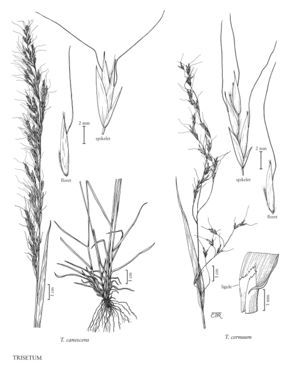Trisetum cernuum
Plants perennial, with both fertile and sterile shoots; cespitose, not rhizomatous. Culms (30) 50-110 cm, clumped, erect, glabrous or pubescent. Leaves 2-3 per culm; sheaths scabridulous or pilose; ligules 1.5-3 mm, truncate, erose to lacerate; blades (8.5) 15-20+ cm long, (3) 7-12 mm wide, flat, ascending, lax at maturity, often scabridulous. Panicles 10-30 cm long, (1) 2-9 cm wide, open, nodding, green or tan, occasionally purple-tinged; branches 2-12+ cm, most, except sometimes the uppermost, spikelet-bearing only towards the apices, with the basal (1/5) 1/3-1/2 bare, filiform, flexuous, at least the lowest 1-3 whorls spreading or drooping. Spikelets 6-12 mm, subsessile to pedicellate, pedicels to 2 cm, usually with 2-3 functional florets below 1-2 reduced florets; rachilla internodes and hairs 1-2.5 mm; disarticulation above the glumes, beneath the florets. Glumes unequal; lower glumes 0.75-2 (3) mm, subulate; upper glumes 3.5-5 mm long, shorter than the lowest florets, 2-3 times as wide as the lower glumes, widest at or above the middle, ovate or obovate, rounded to the acuminate apices; callus hairs to 1 mm; lemmas 5-6 mm, broadly lanceolate, glabrous, bifid, teeth to 1.3 mm, awned, awns (7) 9-14 mm, arising from above midlength to just below the teeth, exceeding the lemma apices, arcuate to flexuous; paleas shorter than the lemmas; anthers about 1 mm. Caryopses 2.5-3.2 mm, densely to sparsely pubescent. 2n = 42.
Discussion
Trisetum cernuum grows in moist woods, on stream banks, lake and pond shores, and floodplains of the western Flora region. The hairiness of the leaf sheaths varies, often within a plant.
Selected References
None.
Lower Taxa
"decumbent" is not a number.
